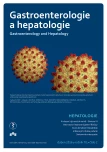Severe life-threatening parasitic liver disease complicated by dissemination to the lungs
Authors:
R. Rosoľanka 1; D. Antolová 2; E. Nováková 3; V. Bartošová 1
Authors‘ workplace:
Klinika infektológie a cestovnej medicíny JLF UK a UN Martin, Slovenská republika
1; Parazitologický ústav, Slovenská akadémia vied, Košice, Slovenská republika
2; Ústav mikrobiológie a imunológie, JLF UK v Martine, Slovenská republika
3
Published in:
Gastroent Hepatol 2016; 70(2): 145-149
Category:
Hepatology: Case Report
doi:
https://doi.org/10.14735/amgh2016csgh.info05
Overview
Alveococcosis is a life threatening tissue parasitosis caused by the larvae of Echinococcus multilocularis, also termed taenia. It results in helminthozoonosis, a parasitosis in which the parasite is transmitted from animals to humans, and where humans act as the accidental hosts. The primary location of the parasite is in the liver, but in rare cases, this can lead to secondary dissemination and the formation of a secondary form of alveococcosis, which most commonly occurs in the lungs and brain. In this case report, we present a case of a 21-year-old patient with alveolar echinococcosis of the liver, complicated by secondary formation of pulmonary lesions. We emphasize the need for a thorough examination of the lungs and the CNS using imaging methods in patients suspected of suffering from alveococcosis.
Key words:
Echinococcus multilocularis – alveolar echinococcosis of the liver – pulmonary echinococcosis
The authors declare they have no potential conflicts of interest concerning drugs, products, or services used in the study.
The Editorial Board declares that the manuscript met the ICMJE „uniform requirements“ for biomedical papers.
Submitted:
18. 10. 2015
Accepted:
20. 11. 2015
Sources
1. Vaništa J. Echinokokóza (hydatidóza) cystická. In: Beneš J et al (ed). Infekční lekárství. Praha: Galén 2009: 359–360.
2. Eckhert J, Schantz PM, Gasser RB et al. Geographic distribution and prevalence. In: Eckert J (eds). WHO/OIE manual on echinococcosis in humans and animals: a public health problem of global concern. Paris: WHO 2001: 100–142.
3. Antolová D, Miterpáková M, Škútová M et al. Echinococcus multilocularis na Slovensku – aktuálna situácia. Infovet 2015; 21(6): 245–249.
4. Eckhert J, Deplazes P. Biological, epidemiological, and clinical aspects of echinococcosis, a zoonosis of increasing concern. Clin Microbiol Rev 2004; 17(1): 107–135.
5. Antolová D, Meterpáková M, Radoňák J et al Alveolar echinococcosis in a highly endemic area of northern Slovakia between 2000 and 2013. Eurosurveillance 2014; 19(34): 20882.
6. Kinčeková J, Dubinský P, Dvorožňáková Eet al. Diagnostika a výskyt alveolárnej echinokózy na Slovensku. Ces Slov Gastroent Hepatol 2005; 59(1): 11–16.
7. Vaništa J. Klinický obraz a léčení alveokokózy. Epidemiol Mikrobiol Imunol 1997; 46(4): 166–167.
8. Szilágyiová M, Michal L, Škračiková J. Výskyt črevných parazitov u detí a dospelých osôb pred odchodom a po návrate zo zahraničia. Slovenský lekár 1992; 2(6–7): 16–20.
9. Šimeková K, Hudečková H. Malária importovaná do Slovenskej republiky zo stredoafrickej republiky. Interná Med 2006; 6(1): 25–27.
10. Šimeková K, Vestenická G, Hudečková H. Ďalší prípad tropickej malárie importovanej do SR. Interná Med 2008; 8(7–8): 417–418.
11. Svihrová V, Szilagyiová M, Krkoska Det al. Analysis of the direct and indirect costs of treatment of imported malaria in the Slovak Republic. Rev Soc Bras Med Trop 2009; 42(4): 377–380.
12. Kern P. Clinical features and treatment of alveolar echinococcosis. Curr Opin Infect Dis 2010, 23(5): 505–512. doi: 10.1097/QCO.0b013e32833d7516.
13. Kinčeková J, Hrčková G, Auer H et al. Clinical and serological study of human alveolar echinococcosis in Slovakia in relation to the outcome of chemotherapy. Helmithologia 2006; 43(4): 213–219. doi: 10.2478/s11687-006-0040-y.
14. Vuitton DA, Bresson-Hadni S. Alveolar echinococcosis: evaluation of therapeutic strategies. Expert Opinion on Orphan Drugs 2014; 2(1): 67–86.
15. Koch S, Bresson-Hadni S, Miguet JPet al. Experience of liver transplantation for incurable alveolar echinococcosis: a 45-case European collaborative report. Transplantation 2003; 75(6): 856–863.
16. Laca L, Olejnik J, Vician M et al. The effects of occlusive techniques on the short-term prognosis after liver resections. Hepatogastroenterology 2006; 53(70): 576–579.
17. Godot V, Harraga S, Podoprigora G et al. IFN alpha-2a protects mice against a helminth infection of the liver and modulates immune responses. Gastroenterology 2003; 124(5): 1441–1450.
Labels
Paediatric gastroenterology Gastroenterology and hepatology SurgeryArticle was published in
Gastroenterology and Hepatology

2016 Issue 2
Most read in this issue
- Eziclen® – reliable method for cleaning the bowel before the colonoscopic examination
- Chronically elevated levels of liver enzymes
- Methods for non-invasive determination of advancement of liver fibrosis
- Severe life-threatening parasitic liver disease complicated by dissemination to the lungs
